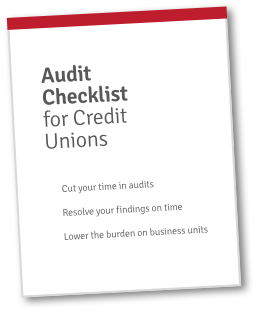Credit Union of the Rockies, a Golden, Colorado-based institution, has built a solid reputation among its growing membership. With 3 branches and just over $120 million in assets, they’re on the smaller side, which allows them to maintain a strong community and member focus.
However, size has its privileges. Credit Union of the Rockies employs around 35 people total, which means that most of the staff wears many hats. So, whereas larger credit unions might have many roles in their audit and compliance department, Credit Union of the Rockies has Benjamin Ferris, Compliance Officer, and he does it all.
Download a PDF of this Case Study Now >
The Trouble(s) with Excel-based Audit Managment
Despite the small team, Credit Union of the Rockies still has a full-size audit schedule. Ferris relies on the timely contributions of other business units to meet the credit union’s goals. He was managing the whole process on Excel spreadsheets—tracking accountability, monitoring deadlines and document requests, and managing findings.
Ferris described the Excel process as “very, very manual,” and troublesome to boot. Too often, Ferris noted, “if we had one Excel spreadsheet and 10 different employees trying to access it… one person would have the file open and another person would make a modification,” causing considerable version control issues.
Additionally, Ferris devoted consistent time to emailing other audit participants about document requests and reminders.
Of all the manual processes inherent to audits, this is one that impacts credit unions of all sizes almost equally. All credit unions must meet similar regulatory requirements for audit schedules; yet with fewer business units to fulfill document requests and handle findings—business units who wear more hats, to boot—it follows that many smaller credit unions feel the strain of audit activity more than their larger counterparts. In our interviews, the hours spent per person, per department, per audit seem to corroborate this trend.
Consequently, any chances at automation, simplification, and improvement in efficiency are critical. So, when Ferris found Redboard, the audit automation platform for credit unions, he brought it on board and invited his business units to complete their audit tasks in it. He noticed the difference immediately. The very first audit they completed—from document and sample requests through findings resolution—he noticed that efficiency was improved throughout.
The Benefits, Efficiency Improvements, and Time Savings... with Redboard
Ferris immediately automated several things. First, he began tracking accountability and deadlines, followed by document request items and findings. He also automated his whole response package—everything from naming conventions to file organization. But perhaps the most impactful thing he automated were his emails; in particular, reminder emails had previously required hours of work per week, but Ferris virtually eliminated the manual portion of that task altogether.
Ferris noticed that the improvements were immediate, as were the time savings. “Frankly, it took one audit… to notice the change. It’s really that quick.” He found that document requests and tracking findings were simpler, more efficient, and more easily organized. With newfound efficiency, Ferris estimates that he’s getting a time savings of about 50–70% on audit administration tasks.
Fortunately, Ferris wasn’t the only person who thrived with a new process. His business units appreciated the minimal learning curve—and how easy and satisfying it was to simply check items off their list.
They no longer get caught up with naming conventions, file placement, and other issues that lead to wasted time and disorganization. “For our business units, it’s been a positive experience overall,” Ferris said.
Beyond creating new operational efficiencies and streamlining business unit workflows, Ferris was able to deliver strategic insights more reliably. Ferris customized reports to make oversight better for his Executive Leadership Team, Supervisory Committee, and Board of Directors. Those decision-making groups found it easier to enforce accountability on the part of those who are assigned findings and document request items.
Reflecting on the improvements he’s been able to make, Ferris notes that without Redboard, “our audit program wouldn’t be as organized. We would absolutely still have more outstanding findings than we do… Redboard helps us manage the audit cycle from planning through document requests, sample requests, findings, finding remediation, plus the supervisory committee and board reporting. It’s a start-to-finish audit management system that makes the audit program of any financial institution more organized, more efficient, and more effective.”


 Get FREE Access to the Audit Checklist for Credit Unions!
Get FREE Access to the Audit Checklist for Credit Unions!


